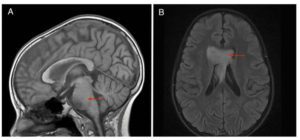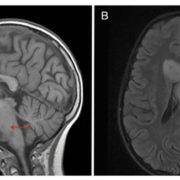
What’s Known
Despite multiple clinical trials testing an assortment of new treatments, the survival rate for diffuse intrinsic pontine glioma (DIPG) remains abysmal, with most children succumbing to the pediatric brainstem tumor within 12 months of diagnosis. Focal radiation therapy, the primary treatment approach, has not improved overall survival. While the majority of DIPG tumors grow within the brainstem, metastases can occur elsewhere in the brain. Due to recent availability of tissue, new data are emerging about the biologic behavior of tumors, details that could be instrumental in constructing optimal treatment strategies.
What’s New
An otherwise healthy 9-year-old girl developed weakness in the left side of her face; magnetic resonance imagining revealed T2/FLAIR hyperintensity centered within and expanding the pons. Despite various treatments, her pontine lesion increased in size and new metastases were noted. The team led by Children’s National Health System researchers is the first to report comprehensive phenotypic analyses comparing multiple sites in primary and distant tumors. All tumor sites displayed positive staining for the H3K27M mutation, a mutation described in more than two-thirds of DIPGs that may portend a worse overall survival. Persistence of mutational status across multiple metastatic sites is particularly important since the effectiveness of some therapeutic approaches relies on this occurring. mRNA analyses, by contrast, identified a small number of genes in the primary tumor that differed from one metastatic tumor. This divergence implies that a single biopsy analysis for mRNA expression has the potential to be misleading.
Questions for Future Research
Q: Because a small cohort of genes in the girl’s primary tumor were different from genes in portions of the metastatic tumor, would genomic and proteomic analyses provide additional details about this genetic evolution?
Q: How do site-specific differences in mRNA expression affect decisions about which therapies to provide and in which order?
Source: “Histological and Molecular Analysis of a Progressive Diffuse Intrinsic Pontine Glioma and Synchronous Metastatic Lesions: A Case Report.” J. Nazarian, G.E. Mason, C.Y. Ho, E. Panditharatna, M. Kambhampati, L.G. Vezina, R.J. Packer, and E.I. Hwang. Published by Oncotarget on June 14, 2016.




